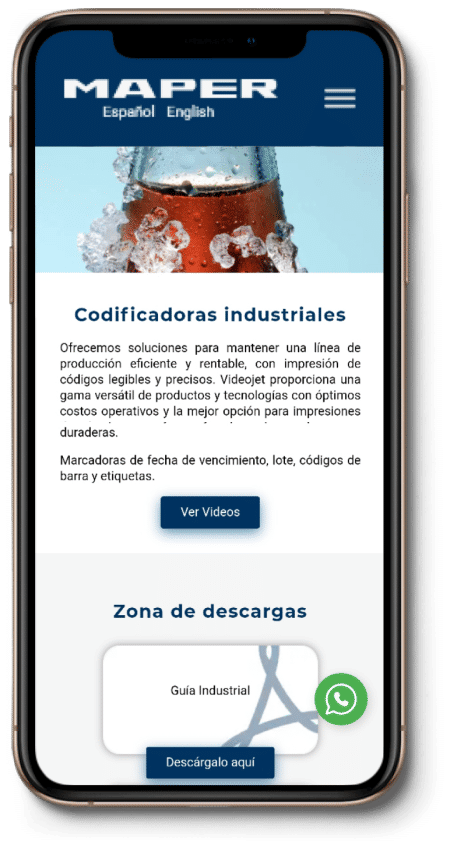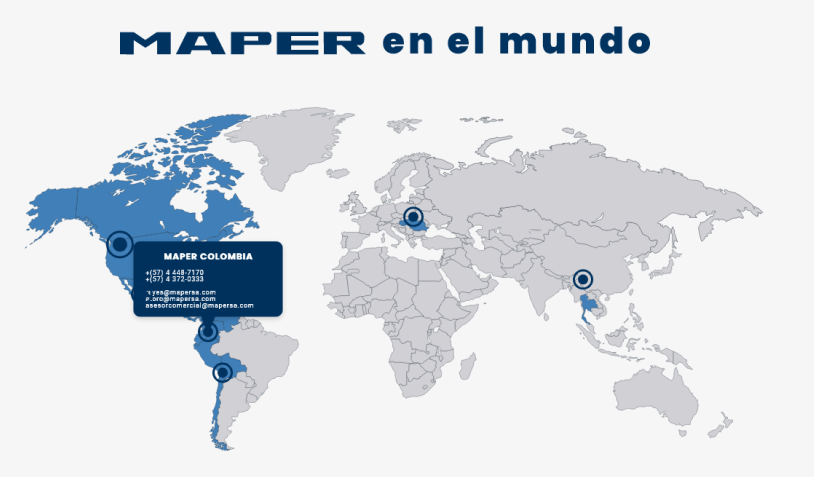

The largest bottler machinery manufacturer of the country needed to give a 180 degrees turn to their online presence, with this renewal they looked to reflect their technological prowess and strengthen the website as a contact and communication medium for existing and potential clients.

Maper came to me with the need to transition from having a purely informative site, to one that works also as a tool for converting their potential users and closing deals. Managing and acquiring leads was set to be the most important metric which they envisioned to measure the success of campaigns at conventions whether they are virtual or in-person. From a second spot but just as relevant, they looked to make their products data visible and accessible for their existing clients as well as support for them. Bearing in mind that the subject and industry was a bit unknown for me, I went on and suggested the client to implement a user centered design process, so each step of this methodology would allow us to work as optimally as we can going through each phase: understand, specify, design and evaluate.

To start the user-centered design process, we kicked off with the understanding phase, the first thing was to get clear data about the client and their business, I did this by conducting a series of interviews with experts on the subject (SME interview) with which I was looking to shorten the understanding process, being aware of the limited time for this step, in this way I was able to separate data into different groups of information to make a customer journey map. From the elements found, I began to shape the goals of the users and how these affect those of the business.
Now in the specify phase, we organize the information and clarify the situations that could help to consolidate the list of problems to prioritize together with the user, we managed to generate a series of hypotheses that could later be verified first-hand when surveying a database of existing users, this led us to create a user profile, compare their needs with what the current site offered and opportunities for improvement.
More than 85% of the participants related primarily to using their cell phones for carrying out processes related to their jobs to a computer.
The majority of users surveyed assured that their greatest need was related to the reduction of response times at their organizations.
All users reported having major pains in the process of quoting with suppliers, either due to lack of clarity in the processes or to delayed or non-existent responses.
Over 70% of the participants commented on having decision-making power in their organizations.

Name: Rafael
Age: 52
Occupation: Production engineer
Rafael is always looking to improve the results of his production plant, by optimizing processes with an aim of reducing loss of materials and time. To make a change or new implementation in his workplace, he needs the supplier to give him a consolidated project to be reviewed by his leaders to carry it out. He hopes that if he creates a new relationship with a supplier, they will be able to train their staff.
After creating our lo-fi wireframes, we prepared a functional prototype that would be tested with a group of 12 company clients, we would ask them 15 questions before starting the usability analysis. We gave different scenarios to each user group hoping to make enough observations for the next iteration of the design.
Too many clicks. We found that one of the main goals, that users quickly find their topic of interest, was not happening with the expected number of clicks.
Channeling the mediums of contact. The client insisted on having two immediate contact options, online chat on the platform and WhatsApp. We noticed that 90% of the users who clicked on a contact medium used the latter.
More locations. Several of the users in the test group had international business in their companies and wondered if Maper had representation outside the country.
Direct downloads. A large part of the target group mentioned not wanting to download documents if they had to fill out forms that would condition access to the file.
We coordinated with Maper’s marketing team, the setting up of a business WhatsApp account to serve customers in a more direct way than with contact forms.

We made a joint effort with the client to summarize and group content so that users could find the content they are looking for, quickly and without many clicks.

We made the decision to translate certain types of content that had large texts contents to more interactive visualization models that allowed to streamline the user’s information process.

The experience with Maper taught me to create dynamics to work with larger groups of people than I was used to, still being able to obtain valuable data for the design process.
The idea of polishing and iterating also in the development of personas to strengthen the concepts of goals from the user and the business was something that I did not deepen into so much in previous projects, I learned that if it is designed only for the goals of the business, the resulting product will have a great chance of failure.